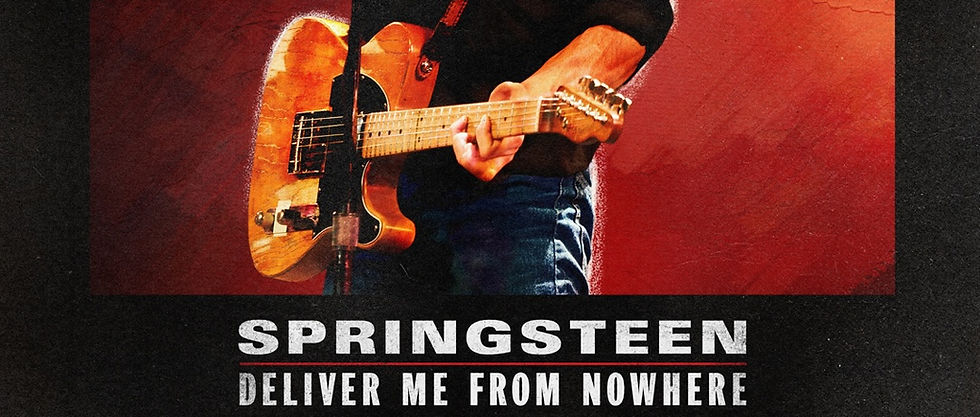BOOK EXCERPT: Expanded 2nd edition of 'Springsteen's Greatest Albums' now available
- Pete Chianca

- Sep 24, 2019
- 4 min read
Longtime readers of Blogness on the Edge of Town will remember “Glory Days: Springsteen’s Greatest Albums,” my 2012 eBook from Endeavour Press analyzing eight classic Springsteen albums and making an argument as to which was his best album ever. (I’d tell you which one it was, but that would be a spoiler.)
Well, Endeavour Press is no more, but just in time for Bruce’s 70th, the second edition of “Glory Days: Springsteen’s Greatest Albums” is here -- in eBook form and, for the first time ever, available in paperback! (For only $5.99 from Amazon.com.)
This new edition is also expanded, including:
New introduction for 2019
New chapter analyzing Springsteen’s first two albums
Updated album rankings
Collected for the first time, six of the most popular Springsteen posts and essays from Blogness on the Edge of Town from 2013-2019
We guarantee it’s the best Bruce book you can get for under $6! But if you’re still not sure, take a look at this excerpt from the new chapter about Springsteen’s first two albums.
The Wild, the Innocent and the E Street Shuffle
Released a mere 10 months later, you’d think “The Wild, The Innocent and the E Street Shuffle” would have just picked up where “Greetings” left off, but apparently Springsteen was having none of that. Right from the noodling horns that give way to wah-wah guitar licks on “The E Street Shuffle,” it’s obvious that this disc, clearly influenced by Van Morrison’s “Astral Weeks,” would be musically far more ambitious -- awash in brass, strings and dueling piano styles, the album immediately conjures a smoky world far different from the cockeyed environs of “Greetings.” Even Springsteen’s vocals seem more relaxed, less effected, while the lyrics jettison frenzy in favor of a languid romanticism we’d come to know even better on his next album.
Most importantly, there’s not a dud to be found from beginning to end -- even the odd, slow oompa ballad “Wild Billy’s Circus Story” display none of the turgidity that saddled down “The Angel” on “Greetings.” Instead its clearly affectionate big-top ramblings are soothing and atmospheric, and Garry Tallent’s tuba certainly doesn’t hurt.
It’s with the second track, “Fourth of July, Asbury Park (Sandy),” that Springsteen’s lyrical development is first apparent, the “showoff talent” Bangs had touted giving way to something more subtle and immediately striking in its storytelling. “The fireworks are hailin' over little Eden tonight, forcin' a light into all those stony faces left stranded on this Fourth of July,” he sings, in a line that’s beautifully literary and feels grounded in a concrete reality at the same time. It kicks off a story of Jersey Shore existence that seems utterly specific and totally universal in a way most songs on “Greetings” weren’t, buoyed throughout by Danny Federici’s melancholy accordion. From there it’s on to “Kitty’s Back,” which forgoes lyrical specificity -- all you really need to know is that Kitty was gone, and now she’s back -- for a jazzy and rollicking jam that wastes no time in establishing the chops of that record’s uniquely talented iteration of the E Street Band: Sancious and Federici in particular, but also the underrated Vini Lopez on drums.
And then comes side 2. Whether “The Wild, the Innocent and The E Street Shuffle” is Bruce’s best album may be debatable, but it’s hard to argue that this isn’t one of his best album sides -- or dare I say one of the best ever, by anyone. (For what it’s worth, it finished second in a poll of Springsteen album sides on Blogness on the Edge of Town, trailing “Born to Run” side 1 by a mere four votes.)
It kicks off with “Incident on 57th Street,” the story of Spanish Johnny and Puerto Rican Jane that’s part noir novella and part gangland musical, beautifully narrated by Springsteen’s street-weary narrator. Like “Lost in the Flood,” it acts in some ways as a preface to “Jungleland,” but stands alone in its lyrical New York vistas and spirit of foregone melancholy. It also builds to a crescendo that heralds the greatest transition of any Springsteen record: Sancious’s delicate piano lullaby giving way to Bruce’s jangling guitar and Clemons’ blaring sax in perfect counterplay. We hadn't really heard unvarnished joy on a Springsteen album yet, but that’s exactly what “Rosalita” represented, and it was spine-tingling. Bruce pulls out all the stops, laying on the over-the-top characters (Big Balls Billy, anyone?), the thrill of escape, the transformative power of rock ’n’ roll -- in the form of a big advance from the record company -- and, for good measure, the swamps of Jersey. With “Rosalita,” it became abundantly clear that, Springsteen’s individual talent aside, he was fronting a band that was going to take you places you couldn’t get to on your own.
After “Rosalita,” you’re exhausted and most likely unprepared for the sad beauty of “New York City Serenade,” which closes the album. Opening with gentle strumming that gives way to brooding classical piano and then a Gershwin-esque jazzy riff, it eventually settles into a languid urban fantasy, Springsteen again comfortably filling the role of whispering, winking storyteller. “It's midnight in Manhattan, this is no time to get cute,” he warns, buoyed by perfectly arranged strings and bongos -- almost dreamlike until he takes a detour in the song’s center to declare with a shouting chorus that “She won’t take the train,” before settling back into slow, smoky brilliance. In summing up Springsteen’s idealized NYC, it’s both audacious and beautiful, like the album as a whole.
Order “Glory Days: Springsteen’s Greatest Albums” in paperback here and in digital format here.









Comments